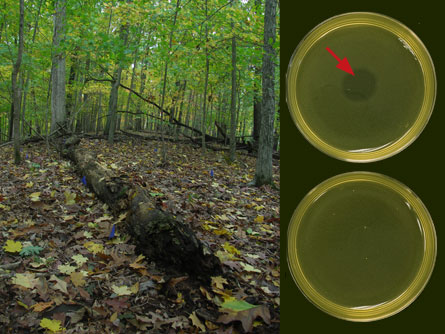Even without parking spaces, office refrigerators or other incitements to nastiness, bacteria in the wild can get downright spiteful.

Bacteria from an Indiana hillside produce toxins that can kill rival strains of the same species that live several meters away, says evolutionary ecologist Hadas Hawlena of Indiana University in Bloomington. Such toxins, called bacteriocins, also hurt their producers by slowing growth or requiring that bacteria burst and die to distribute them.
From an evolutionary point of view, spite poses entertaining puzzles. As Andy Gardner of the University of Oxford in England puts it, ”Why would it ever pay an individual to perform a behavior that reduces its own reproductive success? This seems to go against the idea of the ’survival of the fittest.’”
There’s no evidence the individual bacterium with a piddling growth curve or explosive death gets any immediate benefit from the bacteriocin. In terms of evolutionary biology, that’s outright, outdoor spite, according to a paper by Hawlena and her Indiana colleagues in the March American Naturalist.
“It’s suffering just to make others suffer,” Hawlena says, at least in terms of direct benefits.
Lab experiments with other bacteria have already shown how bacteriocin encounters can turn spiteful, says evolutionary biologist Stu West, also of Oxford. “What this paper does is build on this, by showing that such interactions can also occur in nature, over spatial scales that are meaningful for bacteria.”
Meters matter for these bacteria, because they hitchhike in nematode worms that move about one meter searching for an insect to infect. Once inside the insect, both nematode and bacteria thrive and reproduce, killing the insect in the process. Then the bacterial offspring hitchhike in nematode offspring for another meter or so.
Hawlena and her colleagues tested for natural spite in strains of Xenorhabdus bovienii bacteria collected from soil on a local hillside and brought into the lab. Two strains that had been living just four meters apart on the hill could damage each other with toxins. A third strain, collected five meters farther along the hillside, succumbed to extracts from one neighbor but not from the other.
Varied bacteriocins could maintain microbial diversity at small scales, says evolutionary biologist Tamás Czárán at Eötvös University in Budapest. In a computer simulation, he and his colleagues have shown that three bacterial strains can coexist indefinitely if their killing powers interact in a rock-paper-scissors pattern.
Evolutionary theorists had debated whether spiteful behavior could arise. But until this decade, “we didn’t really think you could get spite,” West says. Now, he accepts as spiteful the parasitoid wasp larvae that become sterile soldiers and kill unrelated competitor larvae within the host. Bacteriocins also fit the spiteful pattern, West says, and “are one of the best couple of examples.”
For a bacterium, spite may be beneficial because it reduces the reproduction of competitors. The spiteful individual may die, but close relatives can pass along shared genes, which won’t be as diluted by the competitors’ in the next generation’s gene pool. For a bacterium or nonreproducing female insect, Gardner says, “even suicidal spite can pay, if she manages to take out enough of her enemies with her.”






